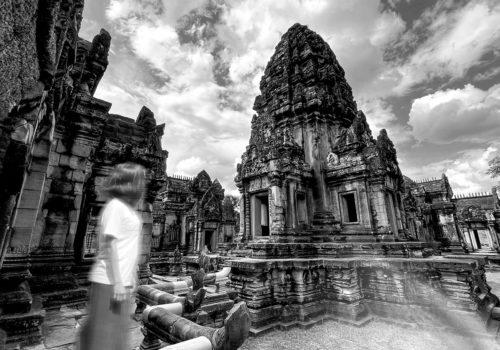Ly Sovanna : Ranoch Visited Angkor
Photography can sometimes allow us to visualize dreams and facts that never existed. This is what Ly Sovanna asked for his series, the very first of his photographic proposals and which he called Ranoch Visited Angkor. “Ranoch” refers to a period when the moonlight becomes increasingly weak at night and Ly Sovanna, born in 1979 in Kampong Cham province and raised in Kampong Thom province, connects it to the death of his mother, whom he lost when he was 13 years old before becoming an orphan the following year. They had both dreamed of going together to visit Angkor Wat, of which she had told him: “Angkor Wat is magnificent and has many sculptures and beautiful Apsaras. For the rest of our lives, it will be a great blessing if we visit Angkor Wat .” Since life did not allow us this visit, Ly Sovanna the communication professional realized it in photography.
However, photography was not, until recently, Ly Sovanna’s means of expression. After obtaining a degree in information technology in 2003, he was responsible for Catholic media for the National Catholic Office of Social Communications of the Catholic Church in Cambodia until 2009, as well as a journalist. From 2005 to 2009, he was a correspondent for UCANEWS in Cambodia. Since 2009, Sovanna has been in charge of distributing information for the National Catholic Office of Social Communications in Cambodia. From 2009 to 2014, he was a member of the board of directors of SIGNIS ASIA (SIGNIS is the World Catholic Association for Communication). From 2014 to 2017, he served as vice president of SIGNIS ASIA. Although very interested in photography, it was only in 2024 that he joined Mak Remissa’s Nimith Art Space where he developed his project on Angkor.
To allow his mother to visit the temples in images, he called on colleagues, women who, alone, pose in the ruins, walk around, contemplate bas-reliefs, fit into the geometry of a door, meet tourists, pose with the characteristic architecture in front of the three towers of the mountain temple, the only monument to appear on a national flag. And, quite naturally and in perfect harmony with the title of the series, the full moon invited itself in one image and drew the silhouette of the visitor and that of the majestic ruins. But the image of these young women is most of the time blurred or moved to avoid making them too present. Photography can reinvent the perception of the world or show us what does not exist, but it cannot bring the deceased back among us. The choice of black and white is part of his desire not to put us in front of images that are too realistic. They are not ghosts, but not really humans either, just presences to dream today of a past that was impossible yesterday.
Christian Caujolle
Exhibition at the Bophana Center from November 21 to December 23, 2024
https://bophana.org/en
















